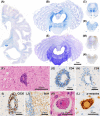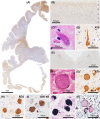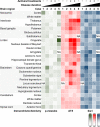Independent distribution between tauopathy secondary to subacute sclerotic panencephalitis and measles virus: An immunohistochemical analysis in autopsy cases including cases treated with aggressive antiviral therapies
- PMID: 35373453
- PMCID: PMC9616085
- DOI: 10.1111/bpa.13069
Independent distribution between tauopathy secondary to subacute sclerotic panencephalitis and measles virus: An immunohistochemical analysis in autopsy cases including cases treated with aggressive antiviral therapies
Abstract
Subacute sclerotic panencephalitis (SSPE) is a refractory neurological disorder after exposure to measles virus. Recently, SSPE cases have been treated with antiviral therapies, but data on the efficacy are inconclusive. Abnormal tau accumulation has been reported in the brain tissue of SSPE cases, but there are few reports in which this is amply discussed. Five autopsied cases diagnosed as definite SSPE were included in this study. The subject age or disease duration ranged from 7.6 to 40.9 years old or from 0.5 to 20.8 years, respectively. Cases 3 and 4 had been treated with antiviral therapies. All evaluated cases showed marked brain atrophy with cerebral ventricle dilatation; additionally, marked demyelination with fibrillary gliosis were observed in the cerebral white matter. The brainstem, cerebellum, and spinal cord were relatively preserved. Immunoreactivity (IR) against measles virus was seen in the brainstem tegmentum, neocortex, and/or limbic cortex of the untreated cases but was rarely seen in the two treated cases. Activated microglia were broadly observed from the cerebrum to the spinal cord and had no meaningful difference among cases. Neurofibrillary tangles characterized by a combination of 3- and 4-repeat tau were observed mainly in the oculomotor nuclei, locus coeruleus, and limbic cortex. IR against phosphorylated tau was seen mainly in the cingulate gyrus, oculomotor nuclei, and pontine tegmentum, and tended to be observed frequently in cases with long disease durations but also tended to decrease along with neuronal loss, as in Case 5, which had the longest disease duration. Since the distribution of phosphorylated tau was independent from that of measles virus, the tauopathy following SSPE was inferred to be the result of diffuse brain inflammation triggered by measles rather than a direct result of measles virus. Moreover, antiviral therapies seemed to suppress measles virus but not the progression of tauopathy.
Keywords: autopsy; measles virus; neurofibrillary tangle; subacute sclerotic panencephalitis; tau.
© 2022 The Authors. Brain Pathology published by John Wiley & Sons Ltd on behalf of International Society of Neuropathology.
Conflict of interest statement
The authors declare no potential conflict of interest.
Figures




Similar articles
-
On the relationship between measles virus and Alzheimer neurofibrillary tangles in subacute sclerosing panencephalitis.Neurobiol Aging. 1996 Jul-Aug;17(4):527-33. doi: 10.1016/0197-4580(96)00069-3. Neurobiol Aging. 1996. PMID: 8832626
-
TDP-43 pathology in subacute sclerosing panencephalitis.J Neuropathol Exp Neurol. 2024 Mar 20;83(4):251-257. doi: 10.1093/jnen/nlae017. J Neuropathol Exp Neurol. 2024. PMID: 38456313
-
Association of measles virus with neurofibrillary tangles in subacute sclerosing panencephalitis: a combined in situ hybridization and immunocytochemical investigation.Neuropathol Appl Neurobiol. 1994 Apr;20(2):103-10. doi: 10.1111/j.1365-2990.1994.tb01168.x. Neuropathol Appl Neurobiol. 1994. PMID: 8072641
-
Subacute sclerosing panencephalitis.Rev Med Virol. 2019 Sep;29(5):e2058. doi: 10.1002/rmv.2058. Epub 2019 Jun 24. Rev Med Virol. 2019. PMID: 31237061 Review.
-
Subacute sclerosing panencephalitis: an update.Dev Med Child Neurol. 2010 Oct;52(10):901-7. doi: 10.1111/j.1469-8749.2010.03717.x. Epub 2010 Jun 15. Dev Med Child Neurol. 2010. PMID: 20561004 Review.
Cited by
-
Neuronal accumulation of hyperphosphorylated tau protein predicts stable memory impairment in people living with HIV.AIDS. 2023 Jul 1;37(8):1247-1256. doi: 10.1097/QAD.0000000000003556. Epub 2023 Mar 28. AIDS. 2023. PMID: 36988209 Free PMC article.
-
Functional properties of measles virus proteins derived from a subacute sclerosing panencephalitis patient who received repeated remdesivir treatments.J Virol. 2024 Mar 19;98(3):e0187423. doi: 10.1128/jvi.01874-23. Epub 2024 Feb 8. J Virol. 2024. PMID: 38329336 Free PMC article.
-
Cryo-EM structures reveal tau filaments from Down syndrome adopt Alzheimer's disease fold.Acta Neuropathol Commun. 2024 Jun 12;12(1):94. doi: 10.1186/s40478-024-01806-y. Acta Neuropathol Commun. 2024. PMID: 38867338 Free PMC article.
-
Tau filaments from amyotrophic lateral sclerosis/parkinsonism-dementia complex adopt the CTE fold.Proc Natl Acad Sci U S A. 2023 Dec 19;120(51):e2306767120. doi: 10.1073/pnas.2306767120. Epub 2023 Dec 15. Proc Natl Acad Sci U S A. 2023. PMID: 38100415 Free PMC article.
-
The structural line between prion and "prion-like": Insights from prion protein and tau.Curr Opin Neurobiol. 2024 Jun;86:102857. doi: 10.1016/j.conb.2024.102857. Epub 2024 Mar 15. Curr Opin Neurobiol. 2024. PMID: 38489865 Free PMC article. Review.
References
-
- Hotta H, Jiang DP, Nagano‐Fujii M. SSPE virus and pathogenesis. Nihon Rinsho Jpn J Clin Med. 2007;65(8):1475–80. - PubMed
-
- Gutierrez J, Issacson RS, Koppel BS. Subacute sclerosing panencephalitis: an update. Dev Med Child Neurol. 2010;52(10):901–7. - PubMed
-
- Hosoya M. Anti SSPE drugs. Nihon Rinsho Jpn J Clin Med. 2012;70(4):625–8. - PubMed
-
- Kovacs GG. Invited review: neuropathology of tauopathies: principles and practice. Neuropathol Appl Neurobiol. 2015;41(1):3–23. - PubMed
Publication types
MeSH terms
Substances
LinkOut - more resources
Full Text Sources

